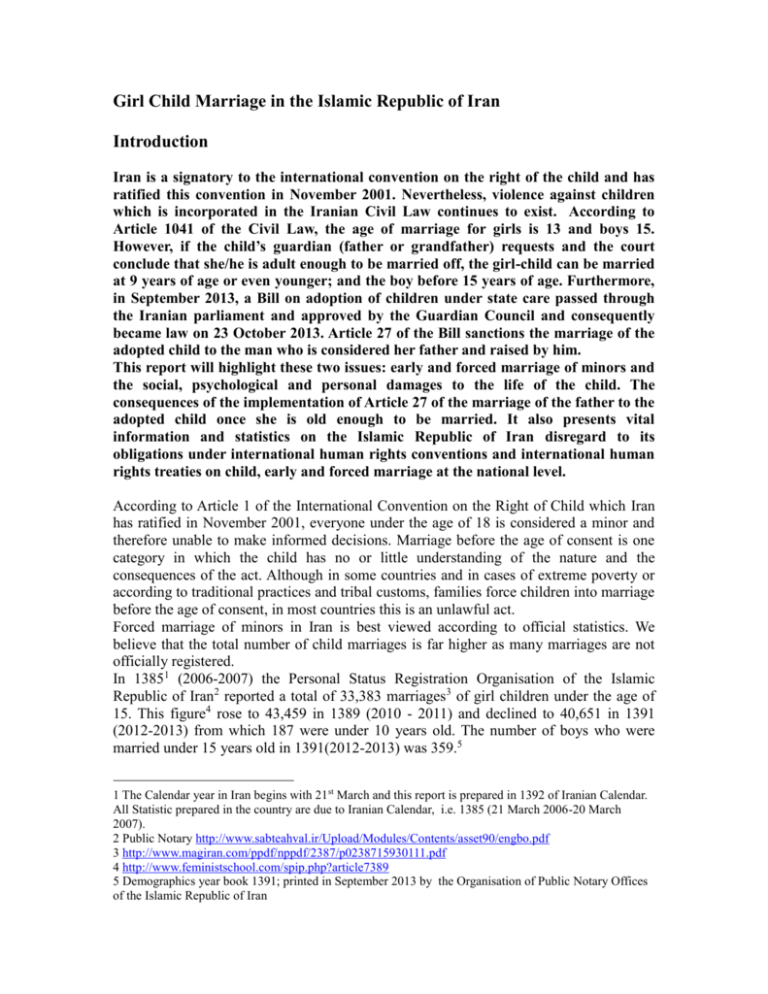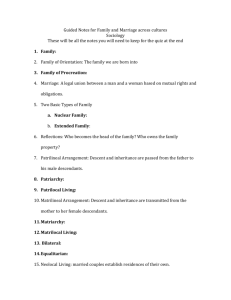Girl Child Marriage in the Islamic Republic of Iran Introduction
advertisement

Girl Child Marriage in the Islamic Republic of Iran Introduction Iran is a signatory to the international convention on the right of the child and has ratified this convention in November 2001. Nevertheless, violence against children which is incorporated in the Iranian Civil Law continues to exist. According to Article 1041 of the Civil Law, the age of marriage for girls is 13 and boys 15. However, if the child’s guardian (father or grandfather) requests and the court conclude that she/he is adult enough to be married off, the girl-child can be married at 9 years of age or even younger; and the boy before 15 years of age. Furthermore, in September 2013, a Bill on adoption of children under state care passed through the Iranian parliament and approved by the Guardian Council and consequently became law on 23 October 2013. Article 27 of the Bill sanctions the marriage of the adopted child to the man who is considered her father and raised by him. This report will highlight these two issues: early and forced marriage of minors and the social, psychological and personal damages to the life of the child. The consequences of the implementation of Article 27 of the marriage of the father to the adopted child once she is old enough to be married. It also presents vital information and statistics on the Islamic Republic of Iran disregard to its obligations under international human rights conventions and international human rights treaties on child, early and forced marriage at the national level. According to Article 1 of the International Convention on the Right of Child which Iran has ratified in November 2001, everyone under the age of 18 is considered a minor and therefore unable to make informed decisions. Marriage before the age of consent is one category in which the child has no or little understanding of the nature and the consequences of the act. Although in some countries and in cases of extreme poverty or according to traditional practices and tribal customs, families force children into marriage before the age of consent, in most countries this is an unlawful act. Forced marriage of minors in Iran is best viewed according to official statistics. We believe that the total number of child marriages is far higher as many marriages are not officially registered. In 13851 (2006-2007) the Personal Status Registration Organisation of the Islamic Republic of Iran2 reported a total of 33,383 marriages3 of girl children under the age of 15. This figure4 rose to 43,459 in 1389 (2010 - 2011) and declined to 40,651 in 1391 (2012-2013) from which 187 were under 10 years old. The number of boys who were married under 15 years old in 1391(2012-2013) was 359.5 1 The Calendar year in Iran begins with 21st March and this report is prepared in 1392 of Iranian Calendar. All Statistic prepared in the country are due to Iranian Calendar, i.e. 1385 (21 March 2006-20 March 2007). 2 Public Notary http://www.sabteahval.ir/Upload/Modules/Contents/asset90/engbo.pdf 3 http://www.magiran.com/ppdf/nppdf/2387/p0238715930111.pdf 4 http://www.feministschool.com/spip.php?article7389 5 Demographics year book 1391; printed in September 2013 by the Organisation of Public Notary Offices of the Islamic Republic of Iran According to Gholampour, former director general of the Personal Status Registration Organisation in the Hormozghan province, 458 marriages of girls under the age of 14 was registered in the first 8 months of 1389 (2010), out of which 5 cases involved children under 10 years. Other figures include: 107 in Bandar Abass, 78 in the city of Minab, 37 in the city of Roodan, 72 in Jask and Bashagard, 10 in the port of Khamir, 34 in Bestak, 26 in port Lengeh, 6 in Parsian and 46 in Ghesm and 24 in Haji-abad. The husbands’ ages varied between17-27.”6 In 1388 (2009-2010) 100 girls below 15 years old were married off to men over 50 years of age. This figure rose to 131 in 1389 (2010-2011).7 The number of registered marriage of girl-children under 10 was 540 in the province of Sistan and Baluchistan, 16 in West Azarbaijan and 34 in Khuzistan. In 1389 (2010-2011) in around 7200 children between10-14 were married off in Sistan and Baluchistan; 5200 in Khuzistan and 2600 in Eastern Azarbaijan.”4 In all, a total of 317 girl children under 10 were married in 1386 (2007-2008), 302 in 1387 (2008-2009), 449 in 1388 (2009-2010), 716 in 1389 (2010-2011), 220 in 1390 (2011-2012) and 187 in 1391 (2012-2013). Director General of Personal Status Registration Office in Tehran State reported 75 marriages of girls and boys under age of 10 in 1390 (2011-2012). The number of marriages of children between 10-14 was 3929 and 19,237 between 15-19 in the same year. The province of Ardebil had the highest number of child marriage under the age of 10 which was 1411 in 1390 (2011-2012). The province of Eastern Azarbaijan had the lowest number of 13 in the same year. According to official statistics rural areas of Esfahan and Sistan and Baluchistan registered the highest number of child marriages under 10. Tables 1 and 2 (attached Excel files) show the detailed frequency of marriage age and gender of children in different provinces in Iran from 1385 to 1390. Unofficial statistics report forced marriage of minors in rural and tribal areas between tribes as a way to settle bloody disputes. The “blood gift” is usually an under-aged girl who will be exchanged without official marriage documents and acknowledgement and therefore treated as slave thereafter8. In the province of Khuzestan, marriage of cousins is a norm. In such cases if the girl declines such marriage, the cousin has the right to kill her. In some cases other male family members such as male siblings or the father do join in the honour killing. According to Article 301 of the Islamic Penal Code “If the father or grandfather murder their daughter they will not receive Ghesas (retribution) but the punishment will be: 1paying the Dieh (compensation). 2- Exile from home by order of the judge. 3Punishment (Ta’ziir) according to the judge’s discretion. 4- Punishment of taking fast for 2 months (Kafareh). 6 http://www.magiran.com/ppdf/nppdf/2835/p0283534140151.pdf 7http://www.tebyan.net/newmobile.aspx/Comment/index.aspx?pid=239366 8 A/HRC/24/NGO/112 (Forced marriages to stop revenge) In such cases if the father, brother or the cousin murders the girl, the father is recognised as the next of kin and eligible to forgive the murderers and settle the whole affair. According to the statistics, honour killings in the region of Kurdistan take the life of many women in only one city one woman is killed each month. Honour killing is carried out in other regions. According to official statistics, in 1388 (2009-2010), 15 women were murdered in under honour killing in the province of Khuzistan.9 An official who did not want his name published reported that: “In 2006-2007 every two months one murder was reported in the south western regions; 10 murders each year10. In 2013, in the city of Bushehr 6 women were murdered under honour killing.”11 Forced marriage of under-aged girls to Afghan families is another issue in Iran. According to Iss’a Mussavi Nasab, foreign affairs general director at the greater Tehran state in some rural areas young girls are sold to Afghan families in exchange of little money. Such marriages are not officially registered.12 Marriage of under-aged girls results in: Deprivation from continuation of education and normal childhood. Article 53 of education bill states conditions for married children as follows: 1- Participation in the final exams without participation in the classes 2- Attending adult evening classes 3- Register at school but not attend classes 4- Attend classes but not allowed to speak of married life The Article does not mention gender of the married child but in effect married boys have no difficulty to continue their education.13 Long-term damages to child-brides can be; Irreversible psychological damages to the child Tear of the vagina and bleeding, infection and sexual diseases Early pregnancy and its consequences to the body of the child Deprivation of normal childhood and adult responsibilities which brings about anxiety, fear, depression and domestic violence. Changes to the Bill on the adoption of children under state care have sanctioned the possible marriage of the father to the child in his care. Article 27 of the Bill reads: “If the head of family wants to marry the adopted child, he should send her details to a court for approval. If the marriage has already taken place, Welfare State Organisation must report it to the court, upon which the decision on the continuation of the care by the same family or its cancellation will be decided.” Article 27 of the Bill on Adoption will have various consequences for the children under state care. Families will be cautious and more reluctant to adopt girls. Sanction of marriage between a child and the man whom she had considered her father while growing up will constitute instability and destroys the fabrics of the family. It contributes to rise in paedophilia which exists in many settings but not researched and acknowledged publicly. In the process of adopting and raising a child, the Bill allows the father to consider the 9 http://www.radiozamaneh.com/101566#.Upc-L-JGam0 10http://www.tabnak.ir/fa/pages/?cid=68015 11 http://www.etemaad.ir/Released/92-05-07/97.htm 12http://www.tebyan.net/newindex.aspx?pid=240397 13http://www.tabnak.ir/fa/pages/?cid=77082 child as a possible sexual being and deprive her of the security and care she needs within the family environment. The Bill paves way for the mother to consider the adopted child as a threat to her livelihood while growing up and that creates a situation with dire consequences for all involved especially the adopted child and other siblings and adoption of female children as a whole. Recommendations: Changes in the Article 53 of the school rules, so that under-aged girl-brides can continue their studies alongside their peers. Steps taken to prohibit child, early and forced marriage by cancellation of Article 1041 of the Civil Law and bringing the age of marriage to the international standards and conventions which Iran is a signatory to them. Implementation of strict rules on the registration of child marriages at the Notary offices and punishment for those who bend the rules and adopting measures and implementing strategies to eliminate the issue. Setting heavy punishment for parents who marry their children or sell them at an early age. Simultaneously seeking ways to get poor families out of poverty as a preventative method to sell their children. Setting up courses and workshops for judges who work at family courts, on international convention on the rights of the child. Setting up courses and workshops on international conventions on the right of child to all involved including those at the welfare state, teachers, and the notary offices, the civil society activists and other relevant stakeholders to promote the elimination of child, early and forced marriage specifically. Action taken to address the issue in communities involved and to address or mitigate its impact, making specific reference to the outcomes of such policies for the health of the nation especially children and women. Inclusion of sex education and family planning to the school curriculum. Cancellation of Article 27 from the bill on adoption. Regular surveys, assessments and studies at national and sub-national level on the prevalence of child, early and forced marriage and/or its impact on the human rights of women and girls and other affected groups. This report has been provided by the All Human Rights for All in Iran project of Verein Südwind Entwicklungspolitik. December 2013







